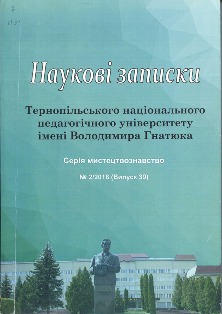ДЖУЗЕППЕ КАСТІЛЬОНЕ ТА ФОРМУВАННЯ НОВОГО КАНОНУ ЖІНОЧОГО ПОРТРЕТУ У КИТАЙСЬКОМУ ЖИВОПИСІ XVIII СТОЛІТТЯ
Ключові слова:
Джузеппе Кастільоне, китайський живопис, жіночий портрет, іконографія, типообразАнотація
У статті досліджено вплив італійського художника-єзуїта Джузеппе Кастільоне (1688–1766) на розвиток жіночого портрета в китайському живописі за часів династії Цин. Розглянуто його досягнення у засвоєнні китайських традицій та поєднанні з європейською школою живопису, створення на цій основі зразків парадного і камерного портретів. Охарактеризовано новації у техніці, стилістиці та жіночих типообразах, які митець приніс із європейського досвіду й затвердив у китайському живописі.Посилання
Golovachov, V. (1995). The Biography of Lan Shi-nin (Giuseppe Castiglione) – Court Artist of the Chinese Emperors, Obshchestvo i gosudarstvo v Kitae [Society and State in China], Vol. XXVI, Moscow, pp. 70–75. (in Russian).
Golovachov, V. (1998). Giuseppe Castiglione (Lan Shin-nin) and His Painting “Eight Noble Horses”: a Picture of the Autobiography of a Court Painter, Obshchestvo i gosudarstvo v Kitae [Society and State in China], Vol. XXVIII, Moscow, pp. 410–415. (in Russian).
Suraeva, N. (2010). Giuseppe Castiglione and His Painting “One Hundred Horses”, Izvestiya RGPU im. A. Gertsena [News of A. Herzen Russian State Pedagogical University], no. 126, pp. 269–276. (in Russian).
Suraeva, N. (2013). The Image of Xiang Fei in the History and Painting of J. Castiglione], Obshchestvo i gosudarstvo v Kitae [Society and State in China], Vol. XLIII, part. 1, Moscow, Institut vostokovedeniya RAN, (Uchenye zapiski IV RAN Otdela Kitaya), no. 8, pp. 536–545. (in Russian).
Suraeva, N. (2011). “At the Origins of the European School of Painting in China: the Artist of the Qing Emperors, Giuseppe Castiglione”, The dissertation of the candidate of Art Studies. Speсials: 17.00.04. “Fine and Decorative Arts, and Architecture”, Moscow V. Surikov State Academic Art Institute, Moscow, 221 p. (in Russian).
Hao Xiao Hua (2015). “Portrait in Chinese Painting: Formation, Stages of Development, the Problems of the Genre in the Art of the XX century”, The dissertation of the candidate of Art Studies. Spesials: 17.00.05. “Fine Art”. Lviv National Academy of Arts, Lviv, 370 p. (in Russian).
Beurdeley, C. and Beurdeley, M. (1972). Giuseppe Castiglione: A Jesuit Painter at the Court of the Chinese Emperors. London: Lund Humphrey, 1972, 204 p. (in English).
Rzepińska, M. and Malcharek K. (1986). Tenebrism in Baroque Painting and Its Ideological Background, Artibus et Historiae, Vol. 7, no. 13, pp. 91–112. (in English).
Portrayals from a Brush Divine: a Special Exhibition on the Tricentennial of Giuseppe Castiglione’s Arrival in China (10/06/2015–01/04/2016), available at: http://theme.npm.edu.tw/exh104/giuseppecastiglione/en/index.html#main (access August 19, 2018). (in English).
Scheuerman, E. (2016). “Our Sister Painter”: The Life of a European Woman in Qing China, Visualizing Traditional China, no. 142, available at: http://humanities.lib.rochester.edu/china/index.php/once-upon-a-time/laura_biondecci/ (access August 29, 2018). (in English).
Truong, Alain. R. (2012). Prized portrait of Consort Chunhui sold for almost HK$40 million at Bonhams Hong Kong 2012, available at: http://www.alaintruong.com/archives/2012/05/28/24358743.html (access August 27, 2018). (in English).
Ling, Zh. (2017). Cultural Exchange. Chinese Court Painter Giuseppe Castiglione (1688-1766), available at: https://www.lyonandturnbull.com/news-article/cultural-exchange-chinese-court-painter-giuseppe-castiglione-1688-1766 (access September 2, 2018). (in English).
Veljkovic, J. (2012). The Fragrant Concubine: An Unsolved Legend Is this Qing Dynasty beauty’s story real, or is it just the fantasy of hopeless romantics?, available at: http://www.theworldofchinese.com/2012/06/the-fragrant-concubine-an-unsolved-legend/ (access August 21, 2018). (in English).
Vossilla, F. (2016). The Jesuit Painter and His Emperor. Some Comments Regarding Giuseppe Castiglione and the Qianlong Emperor, National Palace Museum Bullettin, Vol. 49, pp. 69–88. (in English).
Xue Yunyan, Cai Xingyi. (2000). History of the Chinese Fine Arts of the Qing Dynasty, Beijing, 290 p. (in Chinese).

